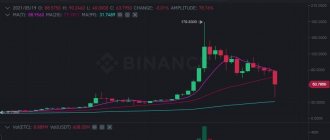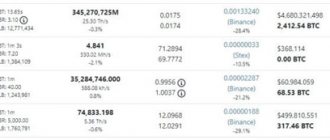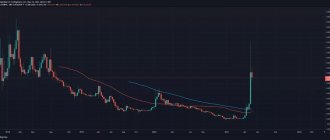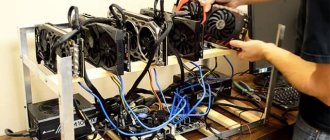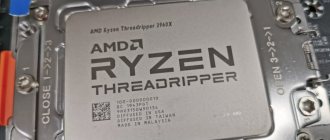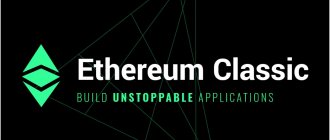In this article, we will step by step analyze the setup of Ethereum Classic (ETC) mining using video cards, especially with 3 GB of RAM, under operating systems such as Windows and HiveOS. You will learn where to store mined coins, how to withdraw them to a card in fiat money, as well as which pool to connect to in order to reduce commission costs.
The article will be useful for those who have not yet sold out or simply have Nvidia 1060 3 GB and AMD Rx 4xx/5xx 4 GB video cards.
Ethereum Classic (ETC) mining algorithm
The Ethereum Classic (ETC) mining algorithm is Etchash. Its main feature is the convenience of coin mining using video cards with at least 3 GB of RAM “on board”.
It is not possible to use ASICs and mining based on NiceHash in ETC mining.
Classic Ethereum, which arose after the problem with the hacking incident “The DAO” (then the blockchain was divided into two separate projects - ETC and ETH), has a number of important parameters. All of them are important both from the point of view of mining and for potential earnings on investments:
- ETC has much higher contract security requirements, which were implemented after the hacker attack that triggered the initial split.
- ETC has an increased transfer speed.
- The project is more exposed to the risks of 51% attacks and has already encountered several such problems.
- Unlike infinite ETH, Ethereum Classic has a limited emission (coin production is limited and will never exceed 210,700,000 units).
What is DAO
DAO is a global smart contract that played the role of a venture capital fund for financing distributed applications. It appeared in the spring of 2016. As a result, users exchanged their ether for DAO tokens and voted for applications that were supposed to receive part of the invested money for development.
A split was supposed to help get out of the DAO. Token owners united into subsystems and returned the invested cryptocurrency. Hackers took advantage of this trick, created their own subsidiary system and transferred more than $50 million in Ethereum to their accounts.
Ethereum developers decided to solve the problem by rolling back the blockchain to the state before the hacker attack. Part of the community supported the idea, while others were strongly against it. The motivation for refusal is reluctance to interfere with the operation of the blockchain, maintaining the autonomy of the system and ignoring the human factor.
The second part of users abandoned the fork and continued the original blockchain. This is how Ethereum Classic was formed.
Ethereum Classic (ETC) Mining Difficulty Calculator
For those who want to decide whether their video card is capable of mining a given asset, there are a number of Ethereum Classic (ETC) mining difficulty calculators. Finding them through search engines is not difficult.
We can recommend using the Minerstat project. Calculation based on it takes just 7 simple steps:
- Go to the “ETC Calculator” section.
- Enter the hashrate of the video cards.
- We indicate energy consumption.
- We fix the pool commission indicator.
- Select the currency for calculations.
- We enter energy costs.
- Click on the “Calculate” item.
Alternative options may also include the following calculators: What To Mine, Profit-mine, Coincalculators, 2CryptoCalc. The latter’s website has a convenient selection with built-in parameters for the most popular video cards.
Development teams
The ecosystem of digital currency etc does not have a single control center; several independent groups of blockchain engineers are working on the project. Each team has its own sector of responsibility
- Ethereum Commonwealth is involved in the Callisto Network test network. The virtual coin Callisto (CLO) is a fork of etc, which is intended to be a “guinea pig”. This altcoin will test all innovations before integrating them into the main network. In addition, this team is responsible for maintaining the official Classic Ether Wallet.
- ETCDEV is a team of programmers from different countries working on network updates.
- IOHK - develops and promotes the Mantis client node, created in the Scala computer language.
- ETC COOPERATIVE - responsible for marketing policy and public relations.
- ETC LABS controls financial issues and ensures the operation of representative offices in Singapore and the USA.
Barry Silbert, head of the Digital Currency Group, played a major role in the development of the project. It must be said that Vitalik Buterin himself never spoke about Ethereum Classic in a negative way. On the contrary, he said that he was following the development of this project with interest, and, recently, already in 2022, he admitted the possibility of completely unifying the two ecosystems.
How to mine on a computer
For those looking for information on how to mine on a computer, Ethereum Classic may be one of the most convenient and promising options. Its algorithm allows you to use even the most average computers by modern standards for mining.
The main system requirements will be:
- availability of a video card from NVIDIA or AMD with RAM from 3 GB;
- Windows or Linux operating system;
- the ability to install a swap file of 5 GB for a video card;
- the ability to install special software for mining.
You will also need to create your own ETC wallet with a unique address. It will receive profits from mining. For this, both storage with a full blockchain (Ethereum Classic Full Node Wallet) and analogues are suitable:
- wallet on the website of a cryptocurrency exchanger (for example, the advanced Matbea platform);
- wallet on the exchange website;
- mobile wallet.
View statistics on pools.
If you mine on the Hiveon pool, then you can go to monitoring statistics in the HiveOS WEB interface, or go to the pool’s home page and enter the address of your ETC wallet.
If the information was useful to you and you want to keep abreast of current news from the world of mining and cryptocurrencies, then support this project by joining our public VKontakte and Telegram channel, we also maintain Twitter with announcements of articles.
Programs for mining Ethereum Classic (ETC)
The list of popular and generally accepted programs includes the following programs for mining Ethereum Classic (ETC):
- Phoenix Miner (used for both AMD and NVidia video cards).
- T-Rex Miner (suitable for NVidia).
- Gminer (universal for two types of video cards).
- LolMiner (another all-rounder).
- NBMiner (NVidia and AMD).
After installation, any of these programs will need to be modified for high-quality mining as part of one of the popular pools. Often, changes will need to be made to a file like “start_miner.bat” (the so-called “batch file”).
Recommendations for creating or editing a “batch file” can be found on pool websites. In most cases, the changes will concern the correct addition of your own wallet address. The rest of the information can simply be copied from the example.
ETC wallet.
I don’t see any point in using any cold or hot wallets for Ethereum Classic because it is quickly mined and exchanged for either fiat or other altcoins for trading.
The best and most convenient option is the internal wallet on the Binance exchange; it has no minimum deposit restrictions, so it will be convenient to withdraw coins from any pool there. And withdrawals are made thanks to P2P trading, which allows you to avoid unnecessary expenses on commissions.
The first step is to register on the Binance exchange itself. Then go to the Wallet section in the Fiat and Spot category.
Find ETC in the search and press Enter.
You will be redirected to a page with your ETC wallet address on Binance. Pay attention to the network, “Ethereum Classic” should be selected.
We will subsequently use the address of this wallet when setting up mining.
How to store and withdraw Ethereum Classic (ETC)
The question of how to store and withdraw Ethereum Classic (ETC) provokes many discussions:
- some choose Ethereum Classic Full Node Wallet from the official website of the project;
- others prefer MyEtherWallet, which requires additional configuration to work with ETC;
- someone keeps their Ethereum Classic savings on crypto exchanges like Binance.
On average, among miners and crypto investors from the CIS, storage, trading and withdrawal in rubles/other fiat currency on the Matbea platform are popular. For the Russian-speaking community, this project stands out with the following characteristics:
- No unnecessary verifications and checks.
- No limits.
- Multi-factor account protection system against hacking.
- One account supports dozens of wallets with popular and exotic currencies.
- There is always the opportunity to buy or sell ETC and other coins for fiat.
- There is passive income through the referral program.
At its core, this is an excellent alternative to foreign exchanges. An analogue that has the same functions, but lacks most of the disadvantages.
Matbi is a Bitcoin wallet and exchanger,
we have been working since 2014
ETC rate and mining relevance
While Vitalik Buterin is thinking about how else to update his Ethereum, squeeze the miners and untie the hands of the coin validators, while he scares everyone with the difficulty bomb and the transition to PoS, large miners and traders have forgotten the ETC rate this spring. They not only showed many people the way to escape in case of a “fire”, but also gave people with old AMD RX 4 GB and Nvidia 1060 3 GB video cards the opportunity to return to normal earnings. The income of such miners depended entirely on the production of the RVN cryptocurrency, now there is a choice.
If we turn to the Whattomine portal, we can see that ETC is higher in profit than RVN on the most profitable and oldest Nvidia 1060 3 GB video cards.
If we take the people's favorite AMD RX 580, but with 4 gigabytes of RAM, we will see a similar picture.
It is more profitable to mine ETH on the eight gigabyte version of the RX 580.
Cloud mining Ethereum Classic (ETC) without investment
Cloud mining of Ethereum Classic (ETC) without investments is most likely unrealistic. Regardless of the site, you will need to invest in the operation of remote equipment either in fiat (rubles/dollars) or another cryptocurrency.
For our part, we can recommend the following algorithm of actions to minimize personal investments:
- we mine cryptocurrency using our PC based on a program for mining and joining a pool;
- We collect the required amount of cryptocurrency in a few weeks;
- We pay for remote cloud mining with these coins and no longer spoil our only device with regular large loads.
Ethereum Classic: cryptocurrency forecasts
Ethereum Classic developers are optimistic in their forecasts. Despite the fact that the reputation of the blockchain has suffered significantly due to hacker attacks on the blockchain, the network shows stability and positive development dynamics. The main question is the further security of the project: if teams can secure the blockchain and attract dApps creators, the network will develop.
Ethereum Classic price chart
The value of the coin is growing quite steadily, experiencing, like others, minor corrections. Why Ethereum Classic has grown:
- the crypto market is in a bullish trend - many coins are growing;
- Ethereum's plans to switch to the Proof-of-Stake algorithm encourage miners to pay attention to other promising coins that can be mined further, and in the case of Ethereum Classic, the profitability may be lower, but more stable;
- faith of crypto enthusiasts in the project and support from major players;
- limited maximum supply implies further price increases;
- increasing the number of developers and traders;
- stability and reliability of the coin.
Profitability
Despite the fairly high price of “Ether Classic”, its mining brings less profit than its “big brother” ETH. You can find out the profit and payback period of a farm using an online mining calculator. There are many of them on the Internet, but Whattomine is considered the most authoritative and accurate. For those who want to start mining ether, a calculator for it will be very useful in terms of profit and payback period for the farm. The advantage of the “classic” currency is the smaller DAG file size and lower mining difficulty. This allows you to mine Ether on weaker cards. For example, the pool simply will not allow a farm on two cards with 2 GB of memory to be mined. At the same time, it can still be used with the classic ether miner.
Select a cryptocurrency to calculate production:
Powered by CryptoRival However, high-end graphics cards generate more income through Ethereum or Zcash.
Conclusion
Against the backdrop of a general drop in cryptocurrency prices, Ethereum Classic mining does not bring such good profits as it did at the end of 2017. It should only be recommended to those who have outdated rigs and video cards that are unsuitable for mining ZEC and ETH. Otherwise, it is better to make maximum use of the capabilities of hardware in order to obtain highly profitable currencies.
Buying farm equipment to engage in ETC crypto mining is quite risky. Despite optimistic forecasts regarding market dynamics, the situation remains consistently bad. Even mining top currencies allows you to recoup costs in only a couple of years. Given the high volatility of cryptocurrencies, the constant increase in the difficulty of mining and unclear forecasts, such investments cannot be considered too reliable. It’s better to try yourself in stock trading or cloud mining. These areas allow you to quickly withdraw assets from business if the situation further deteriorates.
How is network complexity measured?
The difficulty of Eth is measured in so-called “hashes” or, more commonly, “terrahashes” (TH) - a unit of work completed.
Difficulty of Eth (difficulty of Etherium) – how difficult it is to mine this cryptocurrency
What affects the difficulty of Ether
The key objectives of this parameter are to ensure stability in the functioning of the blockchain and the growth of coin emission (i.e. inflation).
The mining load is constantly and automatically controlled, increasing or decreasing the network difficulty in proportion to the number of connected active users. This is done to maintain the number of blocks mined by users per unit of time, which allows, in turn, to slow down the emission of currency and return the block mining time to the standard indicator.
The reverse process is controlled in a similar way. When users leave the network, the number of coins generated per unit of time decreases. As block production decreases, the difficulty decreases.
Mining is controlled by regular changes in the Ethereum difficulty index based on the number of blocks and hashrate that are formed over a certain period of time. For example, if a new cryptocurrency is created faster due to new miners entering the network, the rate increases to balance out the mining of blocks. Conversely, when miners leave the network, Ethereum's difficulty decreases. In this case, balancing does not allow the blockchain to slow down, but it can be disrupted due to the so-called “bomb”.
How are network complexity and network hashrate related?
Another important parameter is the hashrate of the network or, as it is more often called, Ethereum speed. This value shows the productivity of mining equipment. It is abbreviated as hash and is denoted by the letter h. The unit of measurement for mining productivity is hash per second (or hash/second, abbreviated h/s).
A mining farm or video card performs several million operations (or hashes) per second. For example, NVIDIA 1070Ti equipment has a workload of 31 MH/s, that is, it performs 31 million operations in one second.
Essentially, cryptocurrency mining is the process of “guessing” a hash function; users search for the correct solution to a block by selecting existing ones. When it is found, a new task arises, and the “players” try to find another option.
The network hashrate demonstrates the overall productivity of ETH miners. To calculate it, you need to know the difficulty parameters, the average block mining time, which sets the network, and the actual mining time.
Pools for mining
The next step is choosing a pool. A pool is a community of crypto enthusiasts who have pooled resources to mine a specific coin on a special server. The pool distributes the task of decrypting a cryptocurrency block among miners and divides the profit received according to the contribution of each participant.
Where is the best place to mine Ether Classic? Mining etc requires a lot of computing power. A pool with a small number of miners and a weak hashrate will take a long time to search for a block, which will lead to a decrease in income and a delay in payments.
There is no need to register on the Nanopool pool, so just go to the next step and download the program.
Recommended pools for mining etc:
Ethermine - a convenient pool that is in no way inferior to Nanopool
- User-friendly interface and many active users.
- Beautiful website design.
- Reliable servers.
Nanopool - we recommend choosing this pool. Most users choose this one.
- Convenient tracking of farm speed and the number of mined coins.
- Large share of production from the network of large coins.
- There are other popular coins.
- Reliable servers.
Miningpoolhub is the second most powerful pool after Ethermine. Blocks are caught here every minute and a half. In order to join the server you need to create an account. The pool address is https://ethereum-classic.miningpoolhub.com.
